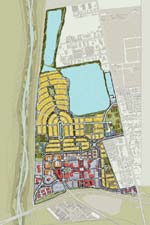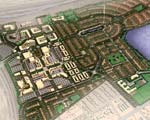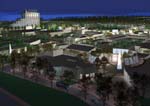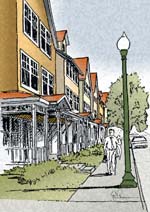
|
|
|
|
 |
|
Home Site Search Contact Us Subscribe
|
|
|
|
Good Urbanism: RiverPark Master Plan by AC Martin Partners
Oxnard, California: 700 acres of abandoned gravel-mining pits and a failed commercial project to be transformed into a model economically viable, environmentally sound, livable community. by ArchNewsNow February 10, 2003 Oxnard is a fast-growing
edge city midway between Santa Barbara and Los Angeles. Like most of Southern
California, it faces overwhelming demands for housing with little available
land. In addition, the community passed an unusual voter initiative in 1998
prohibiting the rezoning of any remaining agricultural land without a voter
referendum. Within this restrictive
context, the developer RiverPark Development called for “a ‘landmark’ new
community using the best planning practices” that would gain the support of
local governing agencies and residents, resolve critical environmental issues
responsibly, capture the economic potential of the site, and most importantly,
create a strong sense of place in the region. Los Angeles-based AC Martin
Partners, Inc. (ACMP) resolved these issues in the design of RiverPark, a community of 2,800 housing
units and 2.5 million square feet of commercial space on 700 acres. The site,
near Pacific Coast Highway and the 101 Freeway, included a failed 300-acre
commercial project from the 1980s and abandoned gravel-mining pits. After
reviewing the Specific Plan and Environmental Impact Report, the Oxnard City
Council approved the planned community in August 2002. The $750 million project
is the result of partnerships with the city, county, Caltrans, the water
district, the school district, environmental agencies, and community groups. ACMP and RiverPark
Development have organized an impressive team of experts to develop the plan
including: RTKL, commercial planning; EDSA, landscape planning; and William
Hezmalhalch Architects, residential design guidelines. “We are gratified by the
council’s action, and the positive reaction from the community,” says Richard
Thompson, AIA, AICP, director of urban design and planning at ACMP, who led the
consultant team that developed the master plan. “It’s a confirmation that
’urbanism’ isn’t new or old – it’s just good or not.” Socially Responsible Development Of particular note is the
approach to the provision of much-needed affordable housing. By working closely
with local affordable housing groups, the developer was able to set aside 15
percent of the residential units for affordable housing, as well as create the
potential for additional affordable units, which would bring the total of
affordable housing to more than 27 percent. In addition, recognizing the
critical need for farm-worker housing in this agricultural region, RiverPark
includes a 4 percent set-aside for very low-income housing. These efforts to
insure the inclusion of affordable housing in RiverPark neighborhoods will
promote the social diversity sought after (but not often achieved) in New
Urbanist communities. “RiverPark shows that
developing quality new community environments requires – in addition to vision
– the willingness to partner with local citizens and public officials to build
a balanced development that provides a wide range of benefits for all parties –
the proverbial win-win situation,” Thompson adds. Other socially responsible
elements include three public schools operated by the local school district;
city/county fire station; storefront police center; post office; library; and
other public facilities. Residents and the surrounding community will have
access to a network of neighborhood parks, community sports fields, jogging
trails, and pedestrian pathways. Public streets, an important part of the
public realm, will have ample sidewalks, street trees, and lighting. Environmental Elements: - Earmarks more than one-third of the land to an
extensive system of parks and open spaces distributed throughout the community. - Converts existing mining pits into water storage and
recharge basins that will serve as a regional water resource and provide visual
and recreational amenities for residents. Storm water runoff will be collected
and treated in a series of bio-swales and retention basins. - Encourages pedestrian activity by clustering most
destinations within a five-to-10-minute walk, while creating a network of streets that
accommodates automobiles without allowing them to dominate. Economic Considerations: - Creates a balanced commercial district that features
a diverse mix of local and national retailers, offices, restaurants, and a
food/wine venue that will showcase the region’s agricultural products, all organized
around a central town square. - Provides a new overcrossing and off ramps leading
directly into the center of the commercial district to capitalize on
RiverPark’s preeminent regional location at the intersection of the 101 Freeway
and Oxnard Boulevard. Visibility and accessibility, together with ample
parking, are keys to attracting and retaining a lively mix of retailers, as
well as both regional and local users. RiverPark is moving forward
after only three and a half years of an approval process that typically can
take up to 10 years for a project of this scope. Construction is planned
to start this year and be completed over the next decade. Client: RiverPark Development, LLC Master Plan: AC Martin Partners, Inc. ACMP Planning Team: Richard W. Thompson, AIA
(Principal-in-Charge), Ben Rosenbloom (Project Manager), Dave Davies, Craig
O'Connor, Chris Hahn, Jeff Su, Kevin Hsieh, Joanne Fitzgerald Commercial Planning: RTKL Landscape Planning: EDSA Residential Design Guidelines: William Hezmalhalch
Architects Civil Engineering: Huitt-Zollars Water Quality System Design: Integrated Water Resources Traffic Planning and Engineering: Crain and Associates Reclamation Engineering: Fugro Natural Resource Conservation: Bio-Resource Consultants Environmental Impact Assessment: Impact Sciences AC Martin Partners, Inc. (ACMP) is
an integrated architecture, engineering, and planning firm with a long-standing
tradition of creating environments that have had significant impacts upon their
surroundings through attention to craft, integrity, and social responsibility.
The Los Angeles-based
firm's wide range of clients includes corporations, government agencies,
developers, cultural organizations, and educational institutions. ACMP has
created master plans for Chapman University, Downtown LA’s Grand Avenue, and
Downtown Fresno, among others. Founded in 1906 by Albert C. Martin Sr., the
firm continues to shape the Southern Californian region, creating user-focused,
innovative, sustainable, and aesthetic landmarks for the 21st century. One of the world’s most highly recognized multi-disciplinary
design firms, RTKL has amassed a portfolio of work that
exceeds 1 billion square feet and extends to 60 nations. With 14 offices
located around the globe, the firm’s expertise includes planning and urban
design, mixed-use developments, retail and entertainment centers, hotels,
resorts, office facilities, government buildings, healthcare facilities, and
engineering services |
(click on pictures to enlarge)  (AC Martin Partners (ACMP)) Site plan: RiverPark, a 700-acre mixed-use development in Oxnard, California (ACMP) View from southeast (ACMP) Night view of commercial district (ACMP) View from north (ACMP) Residential street |
© 2003 ArchNewsNow.com